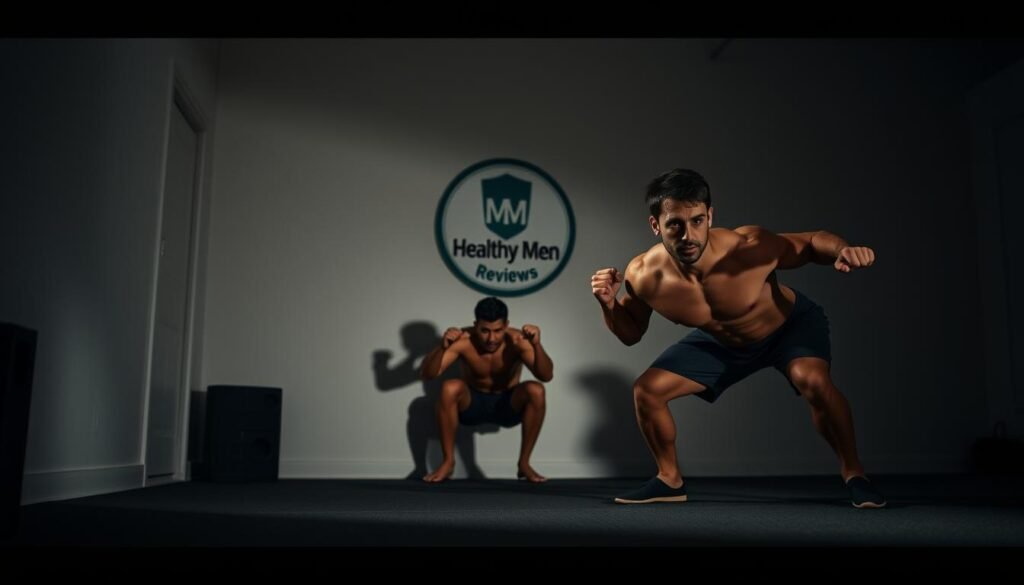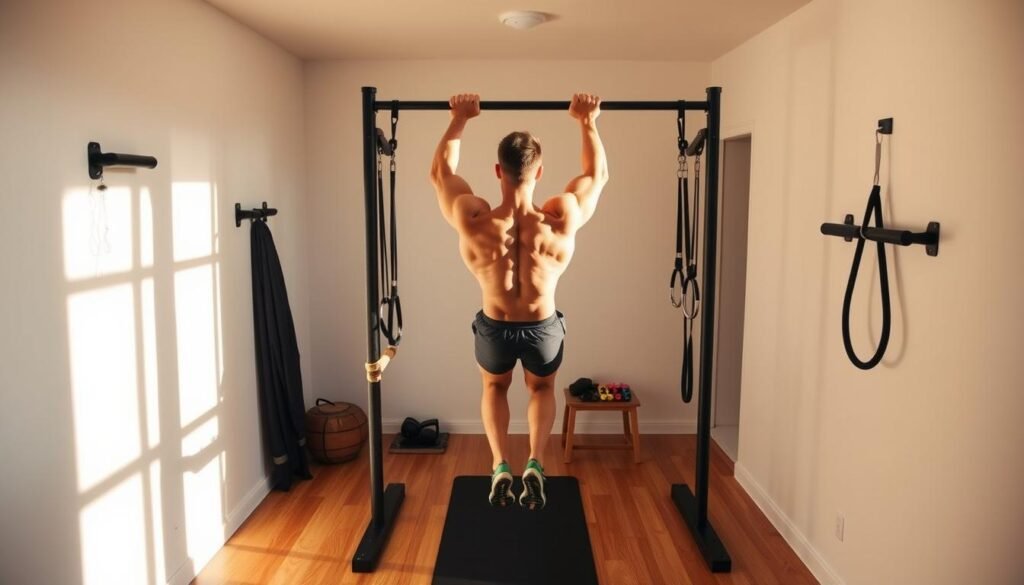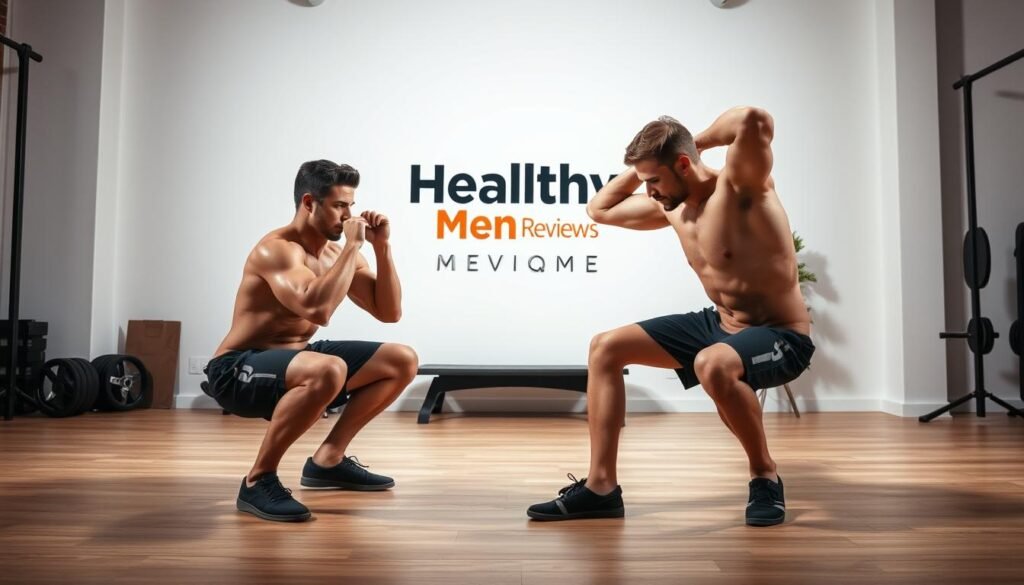You don’t need a gym or any equipment to stay fit. Bodyweight exercises are a great way to boost your fitness and health.
Recent studies show that bodyweight exercises can build strength and muscle mass. They also improve aerobic fitness and help manage fat mass. This makes them perfect for busy people who want to stay fit easily.
Adding bodyweight exercises to your daily routine can help you reach your fitness goals. You don’t need any equipment. This guide will help you get started.
Key Takeaways
- Improve strength and muscle mass with bodyweight exercises.
- Enhance aerobic fitness without any equipment.
- Manage fat mass effectively.
- Convenient and time-efficient workouts.
- Improve overall fitness and health.
Why Busy Men Are Turning to Equipment-Free Home Workouts

In today’s fast world, men are finding the perks of workouts that need no equipment. They’re drawn to home workouts because they’re easy, quick, and effective. This change is all about fitting fitness into their busy lives.
The Modern Time Crunch: Statistics on Male Fitness Participation
Many men find it hard to keep up with exercise because of their tight schedules. A survey found that about 60% of men say they don’t have enough time to work out. This is why home workouts without gym gear are becoming more popular.
The Rise of Minimalist Fitness Approaches
The fitness world is moving towards simpler ways to stay fit, with bodyweight exercises at the forefront. This shift is because bodyweight training is easy and flexible. It lets men get a full workout at home, making it easier to stay active despite their busy lives.
| Fitness Approach | Key Benefits | Target Audience |
|---|---|---|
| Bodyweight Training | Convenience, Flexibility, Cost-Effective | Busy Professionals |
| Minimalist Fitness | Simplicity, Efficiency, Adaptability | Individuals Seeking Ease |
Benefits Beyond Physical: Mental Health Advantages
Exercise does more than just keep you fit; it’s great for your mind too. It can lower stress, boost mood, and help with anxiety and depression. For busy men, a home workout routine is key to staying healthy in body and mind.
Choosing equipment-free home workouts lets men enjoy a complete fitness experience that fits their busy lives. It offers benefits that go beyond physical health, improving their mental well-being too.
The Science Behind Effective Home Workouts No Equipment Men Can Follow

Looking into the science of home workouts without equipment is fascinating. It shows how bodyweight training is backed by solid research. This method is proven to be a complete workout solution.
Research on Bodyweight Training Effectiveness
Studies prove bodyweight training is as good as using weights. A study in the Journal of Strength and Conditioning Research found big gains in strength and endurance. These gains were similar to those from weight training.
Muscle Activation Without Weights: What Studies Show
Bodyweight exercises can work muscles well without weights. For example, push-ups and squats work many muscles at once. This full-body workout is great for functional strength.
Metabolic Impact of Bodyweight Circuit Training
Bodyweight circuit training boosts your heart health and burns calories. It’s because these workouts are high-intensity. This keeps your heart rate up during the workout.
| Exercise Type | Muscle Groups Engaged | Metabolic Impact |
|---|---|---|
| Push-ups | Chest, Shoulders, Triceps | High |
| Squats | Legs, Glutes, Core | High |
| Planks | Core, Shoulders | Moderate |
Adding different bodyweight exercises to your routine is key. It leads to better strength, endurance, and heart health. And you don’t need any equipment.
Essential Bodyweight Exercises Every Man Should Master
To get the most out of your workouts without equipment, focus on key exercises. These exercises target different muscle groups. Mastering them will help you build a strong foundation for your fitness journey.
Upper Body Fundamentals
A strong upper body is crucial for overall fitness. It makes daily tasks easier and improves your physique.
Push-Up Variations for Chest and Triceps
Push-ups are a staple exercise for the upper body. They target your chest, shoulders, and triceps. Try different push-up variations to add variety:
- Standard Push-Up: Works the chest, shoulders, and triceps.
- Diamond Push-Up: Emphasizes the triceps.
- Wide-Arm Push-Up: Targets the chest.
Bodyweight Rows and Pull-Up Alternatives
Bodyweight rows and pull-up alternatives are key for a well-rounded upper body workout. You can perform bodyweight rows using a:
- Bar or ledge: Targets the back and arms.
- Towel or resistance band: Adds variety and challenge.
Lower Body Powerhouses
A strong lower body is vital for mobility, balance, and overall strength. It includes exercises for your legs, glutes, and calves.
Squat Progressions for Strength and Mobility
Squats are a fundamental exercise for the lower body. They improve strength and mobility. Try these squat variations:
- Bodyweight Squat: Works the legs and glutes.
- Sumo Squat: Targets the inner thighs.
- Pistol Squat: Challenges balance and strength.
Lunge Variations for Functional Fitness
Lunges are effective for the lower body and enhance functional fitness. Perform:
- Walking Lunges: Improves balance and coordination.
- Stationary Lunges: Targets the legs and glutes.
- Side Lunges: Works the inner and outer thighs.
Core Strengthening Movements
A strong core is the foundation of overall fitness. It improves stability and reduces injury risk.
Plank Progressions and Hollow Body Holds
Planks and hollow body holds are excellent for the core. Try:
- Standard Plank: Engages the entire core.
- Side Plank: Targets the obliques.
- Hollow Body Hold: Strengthens the lower back and core.
By incorporating these essential bodyweight exercises into your routine, you’ll be well on your way to achieving a stronger, fitter you.
Structuring Your Week: A 7-Day No-Equipment Workout Plan
You don’t need a gym to get in shape. A 7-day no-equipment workout plan can help. With the right plan, you can get fit from home.
Optimal Training Frequency for Results
For home workouts no equipment men, how often you train matters. Studies show training three to four times a week is best. It helps you see results and recover well.
Sample Weekly Schedule for Different Fitness Levels
Here’s a weekly plan for a workout routine for men at all levels:
- Monday: Upper body workout (push-ups, dips, etc.)
- Tuesday: Lower body workout (squats, lunges, etc.)
- Wednesday: Rest day
- Thursday: Core workout (planks, Russian twists, etc.)
- Friday: Full-body workout
- Saturday: Rest day
- Sunday: Rest day or active recovery (light yoga, etc.)
Beginners should start with two to three days. Then, increase as your body gets stronger.
Recovery Protocols Between Sessions
Recovery is key in any workout routine for men. Make sure to sleep 7-9 hours. Also, take rest days as planned. On rest days, try stretching or a light walk.
Adapting the Plan to Your Specific Schedule
Being flexible is important in a home workouts no equipment men plan. If the sample schedule doesn’t work, adjust it. For example, do intense workouts on weekends if weekdays are busy.
By planning your week with a 7-day no-equipment workout plan, you can reach your fitness goals. You won’t need any equipment or a gym membership.
Time-Efficient Workout Formats for the Busiest Men
In today’s fast world, men need quick and effective workouts. Home fitness is now a great option, allowing you to stay fit without long gym hours or expensive gear. No equipment workouts for males are becoming more popular, offering a simple way to stay in shape.
The 15-Minute Morning Routine
Starting your day with a 15-minute workout boosts your energy. A morning routine can include push-ups, squats, and lunges. You can do this at home, needing no equipment.
Lunch Break Express Workouts
For those with tight morning schedules, a lunch break workout is perfect. Even a 20-minute home workout is beneficial, studies show. You can fit in a quick session during your lunch, using your office or a nearby park.
Evening Stress-Relief Sessions
An evening workout can ease stress and tension after a long day. Home fitness routines can include yoga or bodyweight circuits. These help you relax and get ready for the night.
Micro-Workouts: The 5-Minute Solution
For the busiest men, micro-workouts are a great option. These short, 5-minute sessions can be done anytime. Examples include jumping jacks, wall sits, or desk push-ups.
| Workout Format | Duration | Benefits |
|---|---|---|
| Morning Routine | 15 minutes | Boosts energy, improves mental clarity |
| Lunch Break Express | 20 minutes | Increases productivity, reduces mid-day slump |
| Evening Stress Relief | 15-30 minutes | Reduces stress, improves sleep quality |
| Micro-Workouts | 5 minutes | Convenient, can be done anywhere, anytime |
By adding these quick workout formats to your daily routine, you can stay fit without losing time. Home fitness for men has never been easier or more convenient.
Progressive Overload: How to Keep Challenging Yourself Without Weights
Progressive overload is key in bodyweight training. It means pushing your muscles harder than before. This is vital for getting stronger and building muscle, even without weights.
Manipulating Tempo and Time Under Tension
Changing how fast you do exercises is a good way to apply progressive overload. Slowing down your movements makes your muscles work harder. For example, taking 3 seconds to go down during a push-up is tougher on your muscles.
Advanced Bodyweight Progressions
It’s important to keep making your bodyweight exercises harder. You can do this by changing the exercises to be more challenging. For instance, try diamond push-ups instead of regular ones, or single-leg squats instead of regular squats. These changes keep your workouts interesting and stop you from getting stuck.
Tracking Progress Without Traditional Metrics
Since you’re not lifting weights, you can’t use the usual ways to measure progress. Instead, watch how many more reps you can do or how hard you can make the exercises. You can also see how your strength and endurance improve in everyday life.
Breaking Through Plateaus with Minimal Resources
Plateaus happen, but you can get past them. Make your workouts harder by adding more complex moves or less rest time. Try isometric holds or paused repetitions to mix things up and challenge yourself more.
To keep improving in bodyweight training for guys, be creative and keep challenging yourself. Use these strategies in your home workout plan for men to keep pushing yourself without needing any equipment.
- Manipulate exercise tempo to increase time under tension.
- Progress to more challenging bodyweight exercises.
- Track progress through performance and endurance.
- Use isometric holds and paused reps to break through plateaus.
Nutrition Strategies to Support Your Home Workouts No Equipment Men's Program
Nutrition is key to making your bodyweight training at home better. A balanced diet fuels your workouts and helps with recovery and muscle upkeep. As you keep up with your home workouts, knowing the right nutrition is crucial for your fitness goals.
Protein Requirements for Muscle Maintenance
Protein is vital in your diet, more so with bodyweight exercises. It repairs and builds muscle. Aim for 1.6 to 2.2 grams of protein per kilogram of body weight each day. For instance, a 70 kilogram person should eat 112 to 154 grams of protein.
Energy Timing for Optimal Performance
Eating at the right time can boost your workout and recovery. Eat a meal with carbs and protein 1-3 hours before working out. After, have a protein-rich snack within 30-60 minutes to help muscles recover.
Hydration Protocols for Home Training
Drinking enough water is essential for good performance and safety in home workouts. Drink 8-10 glasses of water daily. Make sure to hydrate before, during, and after your workouts. If your urine is pale yellow, you’re drinking enough water.
Simple Meal Planning for Busy Schedules
Meal planning can be easy and quick. Cook proteins and veggies in bulk to save time. Simple meals like grilled chicken with quinoa and veggies, or a protein shake with fruits, are nutritious and quick to make.
By following these nutrition tips, you’ll support your home workout program well. This will lead to better fitness and health overall.
Real Success Stories: Busy Men Who Transformed With Zero Equipment
Many busy men have seen big changes with just bodyweight exercises at home. Their stories show how effective a good workout routine can be, without needing any equipment.
Executive Case Study: From Desk-Bound to Fit
A senior executive, stuck at his desk for 12 hours a day, changed his body in 3 months. He did 15 minutes of bodyweight exercises every morning. He lost body fat and felt more energetic.
Dad Transformation: Finding Time Between Family Responsibilities
A busy dad of three found time for workouts and saw results in 6 weeks. He said being consistent and creative was key. He managed to fit in bodyweight exercises despite his busy family life.
Traveler's Approach: Staying Fit on the Road
A traveler found a way to stay fit while traveling. He did bodyweight exercises in his hotel room. This kept him on track with his fitness goals, even with a busy travel schedule.
Measurable Results and Timeline Expectations
These stories show big changes are possible with bodyweight exercises at home. Most men see improvements in 6 to 12 weeks. They need to stick to their routine and eat well.
“Consistency is key when it comes to seeing real results from bodyweight exercises.” This quote sums up the success stories. It highlights the need for persistence and dedication.
Conclusion: Making Equipment-Free Workouts a Sustainable Part of Your Busy Life
Adding home fitness for men to your busy life can change everything. Bodyweight training for guys is a great way to get fit without spending a lot on equipment or gym memberships.
This guide shows you how to make a fitness plan that works with your busy schedule. Remember, sticking to it is important. Start with easy goals and then make your workouts harder and more frequent.
Bodyweight training can make you stronger, fitter, and happier. Use your time wisely and start your fitness journey now. You can change your body and life, one workout at a time.

